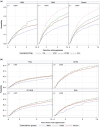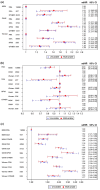Viral rebound on antiretroviral therapy in France according to region of origin, sex, and HIV acquisition group. Results from the French Hospital Database on HIV (ANRS CO4-FHDH)
- PMID: 39497481
- PMCID: PMC11786615
- DOI: 10.1111/hiv.13729
Viral rebound on antiretroviral therapy in France according to region of origin, sex, and HIV acquisition group. Results from the French Hospital Database on HIV (ANRS CO4-FHDH)
Abstract
Background: Assessing the potential increased risk of viral rebound (VR) in migrants requires adequate control for sex and acquisition risk groups.
Methods: People living with HIV1, enrolled in the ANRS CO4-French Hospital Database on HIV, who achieved virological suppression with antiretroviral therapy (ART) initiated between 2006 and 2016 were included. We first compared the risk of VR, with loss to follow-up and death considered as competing events, across origin among the HIV acquisition groups, then across acquisition groups among the different origins, and finally across modality of a variable combining sex, acquisition group, and origin. Models were adjusted for clinical and biological confounding factors.
Results: We included 21 571 French natives (FRA), 10 148 migrants from sub-Saharan Africa (SSA), 1137 migrants from the non-French West Indies (NFWI), and 4205 other migrants (OTHER). The 5-year probability of VR was 19% (95% confidence interval [CI] 19-20) overall, 15% in FRA, 21% in OTHER, 26% in SSA, and 34% in NFWI (p < 0.0001). It was 14% in men who have sex with men (MSM), 23% in heterosexual men, and 23% in women (p < 0.0001). After adjustment, all acquisition groups had a higher risk of VR than MSM from FRA, with men and women from NFWI having the highest risk (adjusted hazard ratio [aHR] 2.46; 95% CI 2.12-2.86 and aHR 2.59; 95% CI 2.20-3.04, respectively). Within each acquisition group, all groups of origin had a higher risk of VR than FRA. Within each region of origin, except the NFWI, heterosexual men had a higher risk of VR than MSM.
Conclusions: After accounting for sex and acquisition group, migration, especially from NFWI, remains prognostic of VR.
Keywords: HIV; geographical origin; heterosexual; migrant; virological rebound.
© 2024 The Author(s). HIV Medicine published by John Wiley & Sons Ltd on behalf of British HIV Association.
Conflict of interest statement
In the past 3 years, FC was a member of the French Gilead HIV board and of the ViiV board. PT was a scientific advisor for Gilead and Pfizer. DR has received travel/accommodations/meeting expenses from MSD. MKJ has received travel/accommodations/meeting expenses from Gilead and MSD and was a member of the ViiV board and the MSD board. RP has received travel/accommodations/meeting expenses and advisory fees from Gilead, ViiV Healthcare and Merck France. The remaining authors have no funding or conflicts of interest to disclose.
Figures



Similar articles
-
Later cART initiation in migrant men from sub-Saharan Africa without advanced HIV disease in France.PLoS One. 2015 Mar 3;10(3):e0118492. doi: 10.1371/journal.pone.0118492. eCollection 2015. PLoS One. 2015. PMID: 25734445 Free PMC article.
-
Influence of geographic origin on AIDS and serious non-AIDS morbidity/mortality during cART among heterosexual HIV-infected men and women in France.PLoS One. 2018 Oct 31;13(10):e0205385. doi: 10.1371/journal.pone.0205385. eCollection 2018. PLoS One. 2018. PMID: 30379870 Free PMC article.
-
Elevated risk of viral rebound on ART in migrants living in France: role of socioeconomic factors.Antivir Ther. 2019;24(7):541-552. doi: 10.3851/IMP3339. Antivir Ther. 2019. PMID: 31868654
-
Influence of geographic origin, sex, and HIV transmission group on the outcome of first-line combined antiretroviral therapy in France.AIDS. 2016 Sep 10;30(14):2235-46. doi: 10.1097/QAD.0000000000001193. AIDS. 2016. PMID: 27428741
-
How do migrants living with HIV adhere to the HIV care process in high-income countries? A systematic review.BMJ Open. 2025 May 8;15(5):e093620. doi: 10.1136/bmjopen-2024-093620. BMJ Open. 2025. PMID: 40345690 Free PMC article.
References
MeSH terms
Substances
Grants and funding
LinkOut - more resources
Full Text Sources
Medical
Research Materials
Miscellaneous

